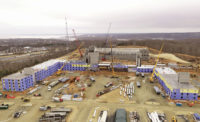The MidAtlantic construction market is finally poised to put the recession in its rearview mirror. ENR MidAtlantic’s annual Top Contractor ranking shows that the survey’s top 10 firms approached pre-recession levels for the first time last year by posting $10.33 billion in revenue in 2015. That’s up from $9.9 billion in 2014 and $9 billion in 2013. The 2008 survey results—which reflect data from 2007, the year the recession officially began—found that the top 10 contractors collected $10.7 billion in revenue.
On the new list, eight of the top 10 firms reported increased revenue from last year, including Kiewit Corp., which leaped three spots to No. 3 after reporting $1.0 billion in revenue. The 55 participating firms from Delaware, Maryland, Pennsylvania, Virginia, West Virginia and the District of Columbia posted a combined $19.05 billion in regional revenue during 2015.
|
View MidAtlantic's 2016 Top Contracting Firms |
“One thing I like about construction is that it is one of the last industries to get hurt in a downturn, but on the other side you are one of the last to get well,” says John R. Lawson II, W.M. Jordan Co. president and CEO.
The Newport News, Va.-based contractor ranked 15th in this year’s survey, up from 18th last year, thanks to a 42.7% revenue increase to $447.03 million. W.M. Jordan attributes the gain to being flexible and diversifying its market sectors and project-delivery methods.
Although revenue has been on the rise for MidAtlantic contractors across almost all sectors in the last several years, federal government contracts still lagged. A key reason was the aftereffects of 2013’s approximately $85.4 billion in mandatory budget cuts, known as sequestration. Lawson said sequestration reduced W.M. Jordan’s federal portfolio by about half. But the firm recently started doing federal work again, including a project at the Little Creek Joint Expeditionary base in Virginia Beach, Va. The firm renovated an 183,000-sq-ft building previously used as a Navy Gateway Inn and Suites and converted it to housing for enlisted personnel. The $32.9-million project achieved LEED Silver certification and met the military’s sustainability goals.
Lawson predicts that military infrastructure and construction work will keep growing because of “all the unrest in the world and the aging weapon systems.”
Modernizing times
The Virginia Beach project is one example of a robust MidAtlantic renovations market. Rather than demolishing older buildings and starting from scratch, many developers have chosen to modernize existing structures. That trend has proved lucrative: contractors reported $5.86 billion in renovation revenue in this year’s survey, up 34.4% from last year.
Drew Mucci, Gilbane Building Co. vice president, says renovations are particularly strong in Washington, D.C., where a 130-ft height limit prevents developers from replacing a 10-story building with one that rises 40 stories. “Instead of knocking something down when you have good floor area,” he says, “you can change a lot of components and stretch your dollar a little better.”
Gilbane—which ranks No. 13 overall in the region with a 17.1% revenue increase to $483.26 million—is currently reskinning an eight-story office building at 900 19th Street NW in Washington. Gilbane is replacing the 1980s precast concrete facade with a 25,000-sq-ft glass curtain wall. It is also modernizing the elevators, constructing a lobby and adding structural components to the 113,577-sq-ft building.
HITT Contracting ranked No. 1 in MidAtlantic renovations with $655 million in revenue. The survey’s overall top-ranked firm, Whiting-Turner Contracting Co., is second in renovations with $617.15 million. ENR MidAtlantic’s Contractor of the Year, James G. Davis Construction Corp. (see p. 15), is third in renovations with $505.03 million. The company is currently doing two noteworthy modernizations in Washington, the Uline Arena and Alexander Court. The Uline project calls for refurbishing the 245,000-sq-ft arena where the Beatles played their first show in the U.S. in 1964. The $135-million Alexander Court project involves adding four floors to an occupied eight-story office building.
Subcontractors in demand
Increased business in all MidAtlantic sectors has intensified demand for high-quality subcontractors. Mucci estimates that signing up some top subs can require a 5% to 10% premium, depending on the trade. He says competition is particularly keen for such specialty trades as masonry or glass and glazing firms.
One factor spurring contractors’ hot pursuit of subcontractors is the robust multi-unit residential market, which jumped 35% in 2015, to $2.15 billion. “Every year I think the bubble is going to pop,” Mucci says. “And it just doesn’t seem to.”







Post a comment to this article
Report Abusive Comment